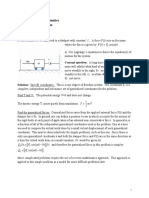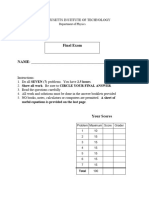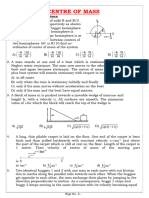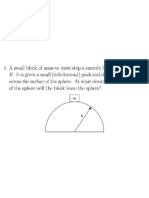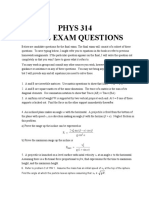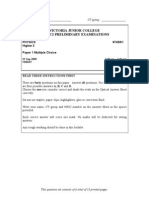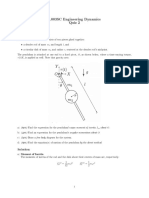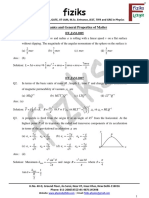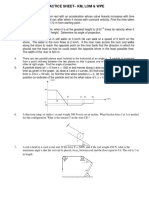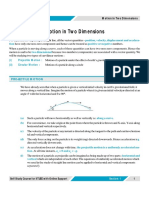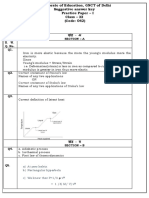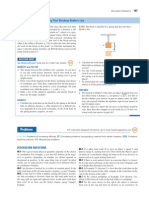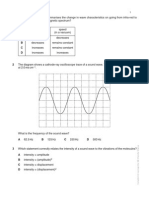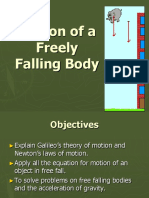PHYSICS 603 - Winter/Spring Semester 2019 - ODU
Classical Mechanics - Problem Set 1
Problem 1)
Consider a vinyl record (now once more fashionable!). Assume it has a single groove that
spirals inward from the edge at radius R2 to the inner radius R1. There are N turns, all
evenly spaced between R1 and R2. Assume I put a (tiny) marble of mass m into the
groove, moving inside the groove frictionless without rolling. Obviously, it has only one
degree of freedom (it can move along the groove, but not perpendicular to it). Use as
generalized coordinate the angle Φ between the starting point (at the outer edge, radius
R2) and the instantaneous position of the marble (increasing by 2π for every full turn).
Express the cartesian coordinates x and y describing the marble position relative to a
fixed coordinate system centered on the record axis in terms of that generalized coordi-
nate. (For the time being, assume the record does not rotate).
Using the same generalized coordinate, write down the (cartesian) velocity of the marble,
and the kinetic energy. Find the generalized force Q in terms of the force components Fx
Φ
and Fy in x- and y-direction. What are the equations of motion for the marble? (Don’t at-
tempt to solve them).
Problem 2)
The position of a particle of mass m moving freely in two dimensions in an inertial Carte-
sian coordinate system is given by (x,y). Write down the particle’s kinetic energy T ( x! , y! )
and the equations of motion. Generalized coordinates q1(x, y, t) and q2(x, y, t) are defined
by
q1 = x cos ω t + y sin ω t
q2 = −x sin ω t + y cos ω t
where ω is a constant. Write down the inverse transformations, x(q1,q2,t) and y(q1,q2,t)
and hence find an expression for T (q!1 , q!2 ,t) in the new coordinates. Obtain the equations
of motion in the new coordinates (including the generalized forces Q1 and Q2). Identify
the extra terms that appear, in terms of so-called “fictitious forces”.
Problem 3)
On page 10 in our book, it is shown how one can split up the total kinetic energy of a sys-
tem of mass points into a part involving the motion of the center of mass only (1/2 M V2;
V = dR/dt) and a term involving the “internal” velocities v’i = vi – V (see Eq. 1.31). Of
!
course, the v’i are not all independent, since ∑ mi v 'i = 0 by the definition of the center of
i
mass. In particular, for a system of only two particles, we can replace v1‘ and v2‘ by a
single variable, v = dr/dt. Here, r = r2 – r1 = r2’ – r1’ is the relative coordinate (the dis-
tance vector) between the two mass points. Show that in this case, you can write the ki-
� PHYSICS 603 - Winter/Spring Semester 2019 - ODU
M !2 µ !2
netic energy with just two terms involving only V and v: T = V + v . Express the
2 2
“reduced mass” µ in terms of the two masses m1 and m2.
Problem 4)
A cylindrical rocket of diameter 2R, mass MR and containing fuel of
mass MF is moving through empty space at velocity v0. At some point the
rocket enters a uniform cloud of interstellar particles with volume density
N (e.g, particles/m3), each particle having the mass m ≪ MR and initially
at rest. To compensate for the dissipative force of the particles colliding
with the rocket, the rocket engines emit fuel at the rate γ with dMF /dt =
−γ at a constant velocity u with respect to the rocket. Ignore gravita-
tional interaction between the rocket and the cloud particles.
1. Assuming that the dissipative drag force from the cloud particles is
−Av2, where A is a constant, derive the differential equation for the
velocity v(t) of the rocket through the cloud as it is firing its engines.
2. What must the rocket thrust γu be to maintain the constant velocity
v0?
3. If the rocket suddenly runs out of fuel, how would its velocity v(t)
decrease with time as the rocket moves through the cloud?
4. BONUS: Assuming that each cloud particle bounces off the rocket
elastically, and collisions occur very frequently, prove that the drag
force is indeed proportional to v2 and estimate the constant A, if the
front nose-cone of the rocket has the opening angle of 90◦.



